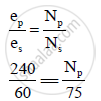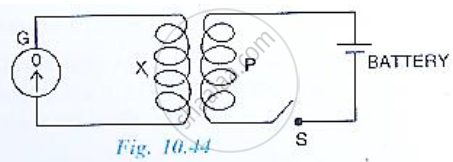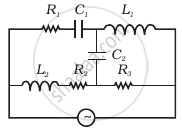Advertisements
Advertisements
Question
A transformer converts 240 V AC to 60 V AC. The secondary has 75 turns. The number of turns in primary are _______.
(A) 600
(B) 500
(C) 400
(D) 300
Solution

∴ `N_p` = 300
APPEARS IN
RELATED QUESTIONS
Explain the construction and working of the transformer.
Write the function of a transformer.
Draw a labeled diagram of a step-down transformer.
Derive an expression for e.m.f. and current in terms of turns ratio
A power transmission line feeds input power at 2200 V to a step-down transformer with its primary windings having 300 turns. Find the number of turns in the secondary to get the power output at 220 V.
State the principle of transformer working with the help of a diagram
The primary coil of an ideal step-up transformer has 100 turns and the transformation ratio is also 100. The input voltage and power are 220 V and 1100 W, respectively. Calculate the
(a) number of turns in secondary
(b) current in the primary
(c) a voltage across secondary
(d) current in secondary
(e) power in secondary
Which coil of a step up transformer is made thicker and why?
Name the transformer used in the power transmitting station of a power plant.
What type of current is transmitted from the power station?
How is the e.m.f. across primary and secondary coils of a transformer related with the number of turns of the coil in them?
You are required to make an electromagnet from a soft iron bar by using a cell, an insulated coil of copper wire and a switch. (a) Draw a circuit diagram to represent the process. (b) label the poles of the electromagnet.
State two factors on which the magnitude of induced e.m.f. depend.
Explain the significance of Lenz’s law to show the conservation of energy in electromagnetic induction.
The following diagram in Fig. 10.44 shows a coil X connected to a sensitive centre –zero galvanometer G and a coil P connected to a battery through a switch S.

(a) Describe the observation when the switch S is (i) closed suddenly, (ii) then kept closed, (iii) finally opened.
(b) Name and state the law which explains the above observations.
The secondary windings of a transformer in which the voltage is stepped down are usually made of thicker wire than the primary. Explain why.
In a transformer, the frequency of A.C. voltage ______.
What is the function of a transformer in an a.c. circuit? How do the input and output powers in a transformer compare?
Describe, with the help of a suitable diagram, the working principle of a step-up transformer. Obtain the relation between input and output voltages in terms of the number of turns of primary and secondary windings and the currents in the input and output circuits.
Mention the two characteristic properties of the material suitable for making core of a transformer.
State the underlying principle of a transformer. How is the large scale transmission of electric energy over long distances done with the use of transformers?
State the principle of a step-up transformer. Explain, with the help of a labeled diagram, its working ?
What is the turns ratio i.e., transformer ratio, ns: np, in an ideal transformer which in-creases ac voltage from 220 V to 33000 V?
What is a transformer? On what principle does it work?
State the principle of a transformer.
Can a transformer be used with direct current source? Give reason.
State the factors on which the frequency of the alternating e.m.f. depends.
What is the function of a step-up transformer?
Name three losses of energy in a transformer. How are they minimized?
Draw a labelled diagram to show the various parts of a step-up transformer and step down transformer.
The power supply to the primary coil of a transformer is 200 W. Find
(i) Current in primary coil if the e.m.f. supply to it is equal to 220V.
(ii) The number of turns in the primary coil is equal to 80 and that in secondary is 800. What is the transformation ratio?
(iii) Name the type of transformer.
(iv) What will be the output voltage?
(v) What is the current in the secondary coil for an ideal transformer?
(vi) What is the output power?
(vii) Is output and input power equal?
(viii) Compare the current flowing in a secondary coil and in a primary coil.
A transformer lowers e.m.f. from 220 V to 15 V. If the number of turns in primary are 3520, how many turns are in the secondary coil?
The primary and secondary coils of a transformer each have an inductance of 200 x 10-6 H. The mutual inductance between the windings is 4 x 10-6 H. What percentage of the flux from one coil reaches the other?
State the mathematical relation between a number of turns in the primary coil to a secondary coil in the step-up transformer.
What is Transformer?
The primary of a transformer has 40 turns and works on 100 V and 100 W. Find a number of turns in the secondary to step up the voltage to 400 V. Also calculate the current in the secondary and primary.
Devices which is used to convert high alternating current to low alternating current is ______.
State whether true or false. If false, correct the statement.
A transformer can step up direct current.
Mention the various energy losses in a transformer.
Give the advantage of AC in long distance power transmission with an illustration.
A 200V/120V step-down transformer of 90% efficiency is connected to an induction stove of resistance 40 Ω. Find the current drawn by the primary of the transformer.
The 300 turn primary of a transformer has resistance 0.82 Ω and the resistance of its secondary of 1200 turns is 6.2 Ω. Find the voltage across the primary if the power output from the secondary at 1600V is 32 kW. Calculate the power losses in both coils when the transformer efficiency is 80%
Assertion: A transfonner cannot work on D.C. supply.
Reason: D.C. changes neither in magnitude nor in direction.
A 100% efficient transformer has 100 turns in the primary and 50 turns in its secondary coil. If the current in the secondary coil is 6 A, then the current in the primary coil is ______.
For an ideal step-down transformer, the quantity which is constant for both the coils is ______.
Which among the following, is not a cause for power loss in a transformer?
A transformer is essentially an a.c. device. It cannot work on d.c. It changes alternating voltages or currents. It does not affect the frequency of a.c. It is based on the phenomenon of mutual induction. A transformer essentially consists of two coils of insulated copper wire having different numbers of turns and wound on the same soft iron core.
The number of turns in the primary and secondary coils of an ideal transformer is 2000 and 50 respectively. The primary coil is connected to a main supply of 120 V and secondary coil is connected to a bulb of resistance 0.6 Ω.
The value of current in the bulb is ______.
A transformer is essentially an a.c. device. It cannot work on d.c. It changes alternating voltages or currents. It does not affect the frequency of a.c. It is based on the phenomenon of mutual induction. A transformer essentially consists of two coils of insulated copper wire having different numbers of turns and wound on the same soft iron core.
The number of turns in the primary and secondary coils of an ideal transformer is 2000 and 50 respectively. The primary coil is connected to a main supply of 120 V and secondary coil is connected to a bulb of resistance 0.6 Ω.
Power in primary coil is ______.
Define a Transformer.
A transformer is used ______
The line that draws power supply to your house from street has ______.
- zero average current.
- 220 V average voltage.
- voltage and current out of phase by 90°.
- voltage and current possibly differing in phase `phi` such that `|phi| < pi/2`.
Draw the effective equivalent circuit of the circuit shown in figure, at very high frequencies and find the effective impedance.

A 60 W load is connected to the secondary of a transformer whose primary draws line voltage. If a current of 0.54 A flows in the load, what is the current in the primary coil? Comment on the type of transformer being used.
Magnetic flux Φ in weber in a closed circuit of resistance 10Ω varies with time Φ (sec) as Φ = 6t2 - 5t + 1. The magnitude of induced current at t = 0.25s is ______.
